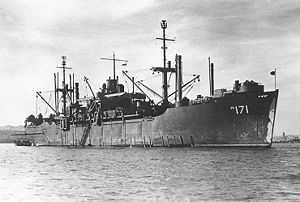USS Granville (APA-171)
 USS Granville (APA-171), probably in San Francisco Bay, 1945 or '46 | |
| Career (US) | |
|---|---|
| Ordered: | as type VC2-S-AP5 |
| Laid down: | date unknown |
| Launched: | 23 October 1944 |
| Acquired: | 21 November 1944 |
| Commissioned: | 21 November 1944 |
| Decommissioned: | 10 May 1946 |
| Struck: | 21 May 1946 |
| Fate: | fate unknown |
| General characteristics | |
| Displacement: | 12,450 tons (full load) |
| Length: | 455 ft 0 in (138.68 m) |
| Beam: | 62 ft 0 in (18.90 m) |
| Draught: | 24 ft 0 in (7.32 m) |
| Propulsion: | one Westinghouse geared turbine, two Babcock and Wilcox header-type boilers, one propeller, design shaft horsepower 8,500 |
| Speed: | 19 knots |
| Boats and landing craft carried: | two LCM, twelve LCVP, three LCPU |
| Capacity: | 150,000 cu. ft, 2,900 tons |
| Complement: | 56 Officers 480 Enlisted |
| Armament: | one 5/38" gun mount, four 40mm mounts, ten 20mm mounts |
USS Granville (APA-171) was a Haskell-class attack transport acquired by the U.S. Navy during World War II for the task of transporting troops to and from combat areas.
World War II service
Named after a county in North Carolina, Granville (APA-171) was launched 23 October 1944 by the Oregon Shipbuilding Corp., Portland, Oregon, under a Maritime Commission contract; sponsored by Mrs. Lowell Stockman; transferred to the Navy 21 November 1944 and commissioned the same day, Captain R. A. MacKerracher in command.
Transporting troops and their equipment to Okinawa
Granville began her transport duties when she cleared San Francisco, California, 26 January 1945 carrying passengers to Pearl Harbor, the Marshalls, Carolines and Marianas. Departing Honolulu 18 April 1945 Granville sortied from Saipan 2 May to land 1,350 troops of the U.S. 10th Army on Okinawa 6–8 May. Already begun, Okinawa was the climax of America's amphibious sweep across the Pacific Ocean.
End-of-war operations
Departing Okinawa 15 May 1945 Granville delivered casualties to San Francisco 10 June via Ulithi, Guam and Pearl Harbor. Clearing San Francisco 26 June she called again at Okinawa with more troops. Granville departed Okinawa 23 August and loaded occupation troops at Lingayen Gulf 10–20 September 1945. Putting her troops ashore at Wakayama, Japan, 25 September she called at Mindanao, Philippine Islands, 9–14 October to embark 1,447 troops of the 2d Battalion, 34th Infantry Regiment. Granville sailed from Mindanao 15 October and landed her troops at Matsuyama 21–24 October 1945; part of the U.S. 5th Fleet landing of the U.S. X Corps (Central Occupation Group), U.S. 6th Army in Kyūshū and western Honshū.
Post-war "clean up" operations
Departing Matsuyama, Japan 28 October 1945, Granville was assigned to the "Operation Magic Carpet" fleet carrying veteran troops to the United States from the Solomons, New Guinea, Admiralties, New Hebrides, and New Caledonia. She returned to San Francisco from her last voyage 25 January 1946, sailed from San Francisco 15 February and reached Norfolk, Virginia, 9 March 1946 via the Panama Canal Zone.
Post-war decommissioning
Granville decommissioned there 10 May 1946. She was returned to the Maritime Commission the next day and her name stricken from the Navy List 21 May 1946. Placed in the National Defense Reserve Fleet, she was berthed in James River, Virginia. Sold for scrapping in 1973.
Military awards and honors
Granville earned one battle star for World War II service. Her crew was eligible for the following medals:
- American Campaign Medal
- Asiatic-Pacific Campaign Medal (1)
- World War II Victory Medal
- Navy Occupation Medal (with Asia Clasp)
Notes on the Haskell class attack transport
The Haskells were very active in the World War II Pacific Theater of Operations, landing Marines and Army troops and transporting casualties at Iwo Jima and Okinawa. Ships of the class were among the first Allied ships to enter Tokyo Bay at the end of World War II, landing the first occupation troops at Yokosuka. After the end of World War II, most participated in Operation Magic Carpet, the massive sealift of U.S. personnel back to the United States. A few of the Haskellclass were reactivated for the Korean War, with some staying in service into the Vietnam War.
The Haskell-class design, Maritime Commission standard type VC2-S-AP5, is a subtype of the World War II Victory ship design.
See also
References
This article incorporates text from the public domain Dictionary of American Naval Fighting Ships.